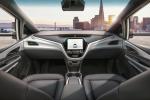Cruise
- Self-driving startup Cruise revealed its new Origin vehicle in San Francisco on Tuesday night.
- The vehicle is fully autonomous, all-electric, and has no traditional controls, such as a steering wheel or pedals.
- It's the result of a partnership between Cruise, GM, and Honda.
- Cruise CEO Dan Ammann continued to argue that it's time for the world to enter a post-car era, with personal auto ownership coming to an end.
SAN FRANCISCO — "We did think about reinventing the wheel," Cruise CEO Dan Ammann joked to an audience that had just seen the former General Motors president reveal the Cruise Origin, the self-driving startup's all-electric, no-steering-wheel, fully autonomous vehicle.
"This is what you'd build if there were no car," he said, building on a radical message first delivered last December, when he argued that the time has come to move past the automobile.
The Origin is the fifth generation of vehicle that Cruise has developed since it was acquired by GM in 2016. Then-CEO (now CTO) Kyle Vogt and his small team had developed a promising self-driving system that could handle the complicated urban environment of San Francisco. Their work caught GM and Ammann's attention. Since then, Japan's SoftBank and Honda, as well as other investors, have raised Cruise's valuation to about $20 billion.
The Origin, which looks very much like the boxy transportation pod that some auto execs have been expecting, is the result of a collaboration between Cruise, GM, and Honda that started in late 2018. It's constructed on a new all-electric platform, the company said, and should form the basis of a shared-mobility service that Cruise hopes to launch in coming years (a 2019 roll-out was pushed back).
A production-ready vehicle, not a concept carThe vehicle — which Ammann said isn't a concept, but is actually going into production, with a plant to be named shorty — is intended to bring over 100 years of individual car ownership to an end.
Ammann said that it could also conclude an era of unfortunate trade-offs caused by long commute times, expensive auto ownership and maintenance, and, of course, the sacrifice of safety. Almost 40,000 people die in car-related accidents every year in the US alone.
"What if we didn't have to choose?" he asked. "What if we could create a different transportation system entirely — one that is safer, better and more affordable for us, for our cities and for our planet?"
The Origin, according to design director Stuart Norris, enabled the Cruise-GM-Honda group to get back to design fundamentals.
"There was no first sketch," he said.
Instead, designers considered how the Origin would be used and experienced, and that informed their approach. "We moved away from styling," he noted. "It was a complete paradigm shift."
Vogt pointed out that, while the box-like Origin might seem large, it's really no bigger than a typical car. But it has no engine, nor conventional controls. The twin doors slide open, minivan-style, to avoid taking out cyclists. Inside there's a pair of bench seats, accommodating six riders, along with dual screens and a cargo area. Four sensor arrays at the corners enable the information flow that enables the vehicle to navigate what Vogt characterized as the entropic and random San Francisco streetscape.
A million-mile vehicleAccording to Ammann, Cruise's service could provide $5,000 in yearly savings for customers who would be liberated from the cost of car ownership. The vehicles would operate around the clock and be updated on ther sensor and software fronts. But the vehicle itself could operate for a million miles.
"We're close to cracking the human performance barrier," Vogt said.
He said the Origin could deliver what he called "superhuman" performance, and that the vehicles could be affordably deployed on a larger scale — at half the cost of an electric vehicle in the current market.
Cruise relies on an integrated-manufacturing process to distinguish itself from other self-driving companies, such as Waymo (part of Alphabet), which wants to develop a robot "driver" that could operate anything from a minivan to a big semi-trailer rig, and has been supplied with vehicles by Fiat Chrysler and Jaguar Land Rover.
By building its own vehicles, at GM factories, with self-driving technology engineered into the car itself, Cruise hopes to be able to vindicate the $1 billion a year GM is spending to fund the company's growth.
And Cruise doesn't appear to be limiting itself to ferrying just passengers. Ammann teased the prospects for a cargo-delivery service, as well.
Critically, none of it would require business-as-usual.
"What we came up with isn't a car that you buy," Ammann said. "It's an experience that you share."
NOW WATCH: Inside Roborace: the Formula One for self-driving cars
See Also:
- Tesla is on a tear, with no end in sight. That means the naysayers' case is in ruins.
- The CEO of Aurora explains why the self-driving startup bought a laser-radar company that's completely off the tech-industry grid
- A GMC exec reveals how the legendary truck maker is challenging BMW, Audi, and Jaguar Land Rover by bucking the luxury trend
FOLLOW US: On Facebook for more car and transportation content!
















